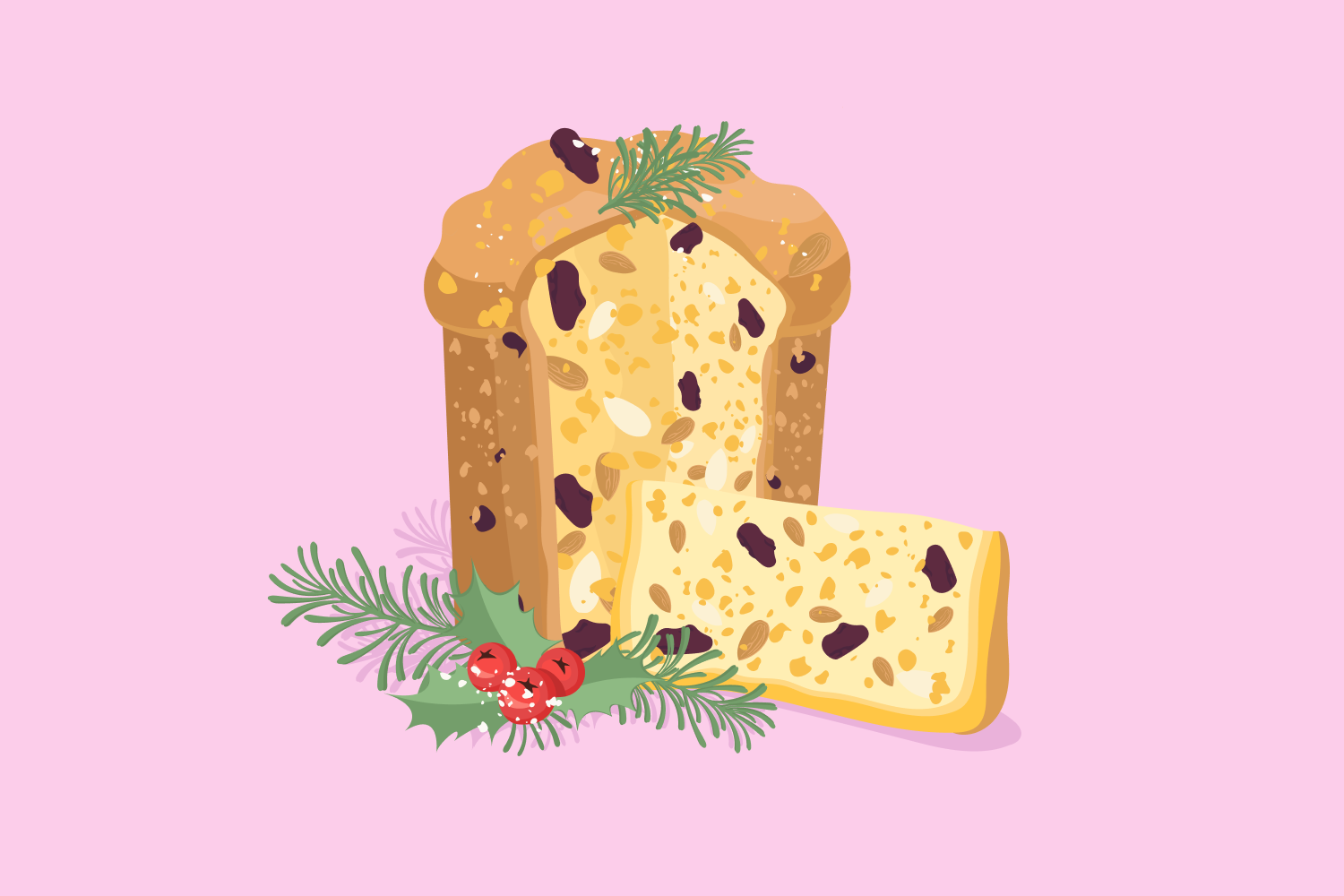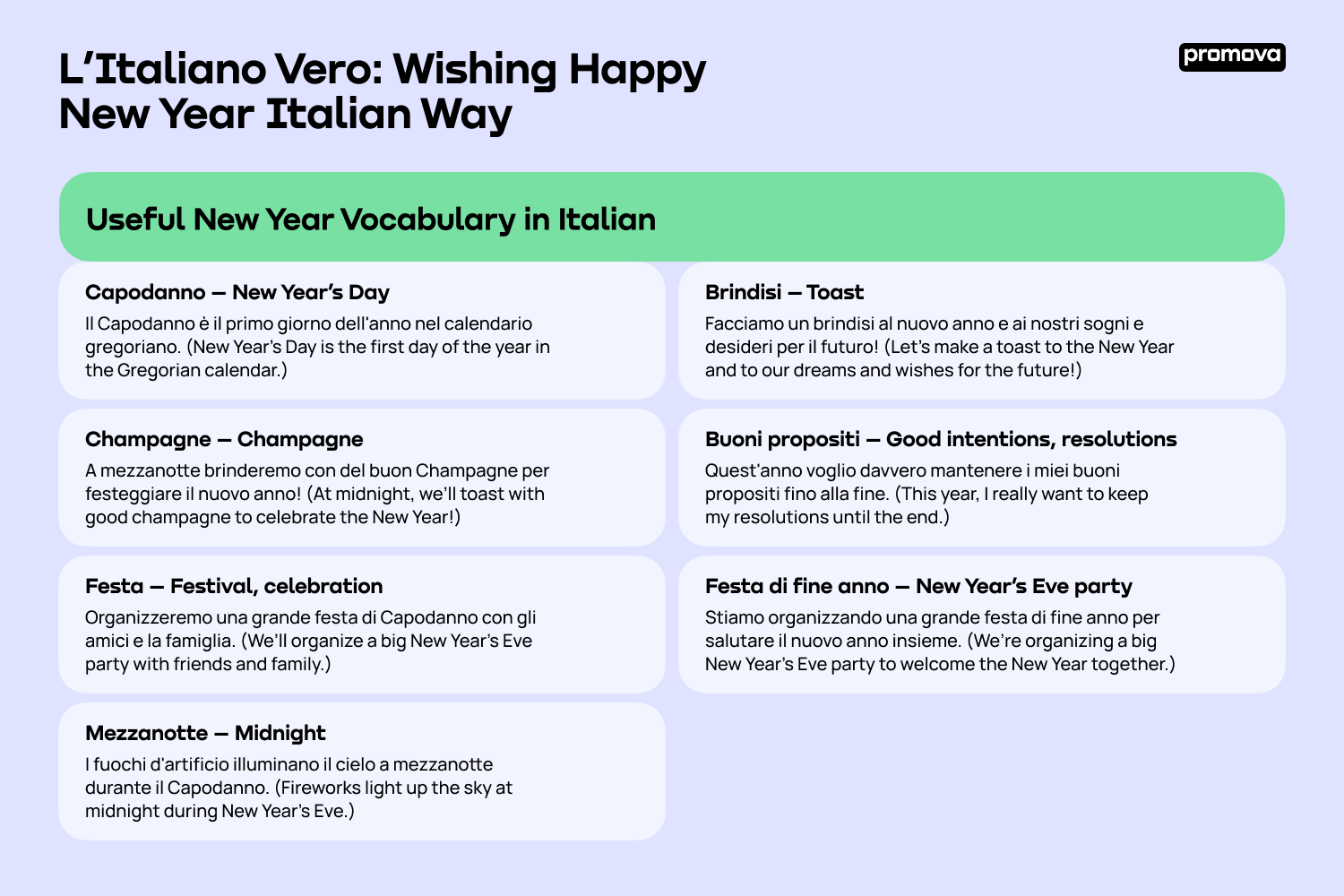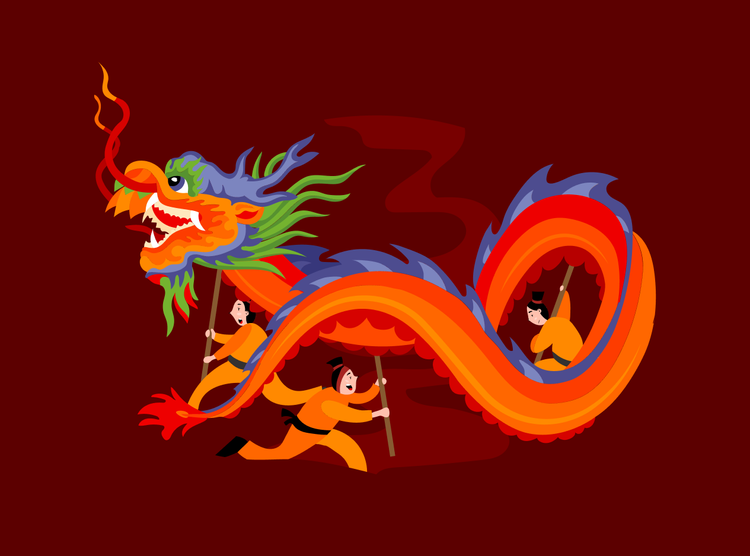L’Italiano Vero: Wishing Happy New Year Italian Way


You will get a promo code with a discount for our app courses after reading this article.
Contents
Italians are renowned for their openness, liveliness, and love of festivities, and these qualities shine through in their New Year greetings. That’s why learning to say Happy New Year Italian way is not only a fantastic opportunity to expand your vocabulary, but it also fills you with joy and excitement. Keep reading, and you will find different phrases, useful vocabulary, and other vital information related to New Year celebrations in Italy!
How Do You Say Happy New Year in Italian: Common Phrases and Greetings
Of course, the first thing you need to know is how to wish someone a Happy New Year in Italian. There are so many incredible options, so it is difficult to choose only one. Hence, we’ve compiled a list of various expressions and phrases that can be handy. So, how to say Happy New Year in Italian?
- Felice Anno Nuovo! – [ˈfɛ.li.tʃɛ ˈan.no ˈnwɔ.vo] – Happy New Year!
- Buon Capodanno! – [ˈbwɔn ka.poˈdan.no] – Happy New Year!
- Che il Nuovo Anno sia pieno di gioia! – [ke il ˈnwɔ.vo ˈan.no ˈsi.a ˈpjɛ.no di ˈdʒɔ.ja] – May the New Year be filled with joy!
- Auguro di Buon Anno! – [ˈaʊɡʊro dˈi bwˈɔn ˈanno] – Wishing you a Happy New Year!
- Prospero Anno Nuovo! – [prosˈpɛ.ro ˈan.no ˈnwɔ.vo] – Prosperous New Year!
- Tanti Auguri di Felicità! – [ˈtan.ti awˈɡu.ri di feliˈtʃi.ta] – Best wishes for happiness!
These are some of the best phrases and greetings you can use during the New Year season. They are suitable for both formal and informal circumstances, so you can choose any of them to greet friends, family members, colleagues, or just people you are familiar with.
Useful New Year Vocabulary in Italian
Now that you know buon anno meaning, it is time to expand your vocabulary even more. Below, you can find some of the most common New Year-related words in Italian, and examples of using them in sentences.
- Capodanno – [ka.poˈdan.no] – New Year’s Day.
Il Capodanno è il primo giorno dell'anno nel calendario gregoriano. (New Year’s Day is the first day of the year in the Gregorian calendar.)
- Champagne – [ʃamˈpaɲ] – Champagne.
A mezzanotte brinderemo con del buon Champagne per festeggiare il nuovo anno! (At midnight, we’ll toast with good champagne to celebrate the New Year!)
- Festa – [ˈfɛs.ta] – Festival, celebration.
Organizzeremo una grande festa di Capodanno con gli amici e la famiglia. (We’ll organize a big New Year’s Eve party with friends and family.)
- Mezzanotte – [met.saˈnot.te] – Midnight.
I fuochi d'artificio illuminano il cielo a mezzanotte durante il Capodanno. (Fireworks light up the sky at midnight during New Year’s Eve.)
- Brindisi – [brinˈdi.zi] – Toast.
Facciamo un brindisi al nuovo anno e ai nostri sogni e desideri per il futuro! (Let’s make a toast to the New Year and to our dreams and wishes for the future!)
- Buoni propositi – [ˈbwɔ.ni pro.poˈzi.ti] – Good intentions, resolutions.
Quest'anno voglio davvero mantenere i miei buoni propositi fino alla fine. (This year, I really want to keep my resolutions until the end.)
- Festa di fine anno – [ˈfɛs.ta di ˈfi.ne ˈan.no] – New Year’s Eve party.
Stiamo organizzando una grande festa di fine anno per salutare il nuovo anno insieme. (We’re organizing a big New Year’s Eve party to welcome the New Year together.)
- Conto alla rovescia – [ˈkonto al.la roˈvɛʃ.ʃa] – Countdown.
Il conto alla rovescia per il nuovo anno è sempre emozionante e pieno di aspettative. (The countdown to the New Year is always exciting and full of expectations.)
- Auguri – [awˈɡu.ri] – Wishes, greetings.
Mandiamo gli auguri di un felice e prospero anno nuovo a tutti i nostri amici e parenti. (We send wishes for a happy and prosperous New Year to all our friends and relatives.)
- Fuochi d'artificio – [ˈfwɔ.ki ˈdar.tiˌfi.tʃjo] – Fireworks.
I fuochi d'artificio sono una tradizione comune durante i festeggiamenti di Capodanno in molte città del mondo. (Fireworks are a common tradition during New Year’s celebrations in many cities around the world.)
- Ballo – [ˈbal.lo] – Dance.
Dopo il cenone, ci sarà un grande ballo per festeggiare l'arrivo del nuovo anno. (After dinner, there will be a big dance to celebrate the arrival of the new year.)
- Abbuffata – [ab.bufˈfa.ta] – Feasting.
Durante il Capodanno, spesso ci si concede un'abbuffata di cibo delizioso e prelibatezze. (During New Year’s Eve, people often indulge in feasting on delicious food and delicacies.)

Happy New Year Italy: Traditional Dishes
Another thing Italy is known for is its delicious food. And when it comes to the holiday season, there are many tasty and unique meals worthy of your attention. Here’s the comprehensive list of Italian New Year dishes and their original names!
- Cotechino e Lenticchie – [ko.teˈki.no e lenˈti.kje] – Cotechino sausage with lentils.
It is a classic dish eaten in Italy on New Year’s Eve. The pork sausage symbolizes abundance, and the lentils represent wealth and prosperity for the coming year.
- Zampone – [dzamˈpo.ne] – Stuffed pig’s trotter.
Zampone is similar to Cotechino but is made with the skin of the pig’s trotter stuffed with a mixture of ground pork, herbs, and spices. It is also typically served with lentils for New Year’s dinner.
- Pandoro – [panˈdo.ro] – Traditional sweet bread.
This one is a golden, star-shaped sweet bread that originated in Verona. It’s often dusted with powdered sugar and served as a dessert during the holiday season, including New Year’s celebrations.
- Tortellini in Brodo – [tor.teˈlli.ni in ˈbro.do] – Tortellini in broth.
It is small ring-shaped pasta filled with meat or cheese, served in a flavorful broth. This meal is a comforting and traditional dish often enjoyed on New Year’s Day in Italy.
- Panettone – [paˈnet.to.ne] – Sweet bread loaf.
Panettone is a tall, dome-shaped sweet bread studded with candied fruits and raisins. It’s a beloved Italian Christmas and New Year’s treat, often enjoyed with a glass of spumante.
- Bruschetta di Capodanno – [bruˈsket.ta di ka.poˈdan.no] – New Year’s bruschetta.
The last food on our list is a festive version of the classic Italian appetizer. It features toasted bread slices topped with a variety of seasonal ingredients, like tomatoes, mozzarella, and basil.
7
Master Italian New Year Wishes and More with Promova
Although learning and memorizing Italian New Year greetings is great for general knowledge, it might not be enough to become fluent in a language. If your goal is to reach proficiency in Italian, focus on mastering the essential skills, such as speaking, reading, listening, and writing. We are happy to help you by introducing you to the Promova app – your one-stop solution for fluency.
The application is available for both iOS and Android devices, so you can easily install it on your gadget and access all the studying materials anywhere and anytime you want. In addition to Italian, the Promova app provides you with the opportunity to learn English, German, French, Korean, and many other languages.
Within the app, you can access a ton of useful materials and valuable features for convenient language learning. For example, you can access engaging lessons created by language professionals. Moreover, in Promova, we provide a bite-sized learning approach, allowing you to spend only a few minutes daily and still access desirable results.
Each studying plan within the application is created according to your fluency level and goals, so you can only focus on learning the essential things for you. Install the Promova app now, and enjoy your studying whenever and wherever you want!
Conclusion
All in all, diving into the Italian language and culture during the New Year season can be an incredibly rewarding experience. From mastering simple yet meaningful phrases to exploring delicious traditional dishes, you not only expand your language skills but also deepen your connection to Italian customs.
Use your discount and learn languages with Promova
Start learningFAQ
What are some famous Italian New Year traditions?
Like many cultures around the world, Italians celebrate the New Year with abundant feasts featuring traditional dishes. In some regions of Italy, people engage in the tradition of throwing old items out of their windows or balconies at midnight to symbolize letting go of the past and embracing the new year with a fresh start.
Why do Italians wear red underwear on New Year’s Eve?
Wearing red underwear on New Year’s Eve is a popular tradition in Italy, believed to bring good luck and prosperity in the coming year. The origins of this tradition are unclear, but red is considered a symbol of fertility, vitality, and energy.
How can you say Merry Christmas in Italian?
There are several ways to wish someone a Merry Christmas! The most common and universal phrase is Buon Natale, which can be used in both formal and informal contexts. Additional options are expressions Felice Natale and Auguri di Buon Natale.
Are there any superstitions or beliefs associated with New Year’s Eve in Italy?
Like people in many other countries, Italians have several superstitions connected with the New Year and New Year’s Eve. For example, there is a strong belief that starting the new year with debts or unresolved disputes may bring bad luck. Therefore, it’s expected to settle debts, reconcile with others, and clear any negative energy before the year ends.



Comments